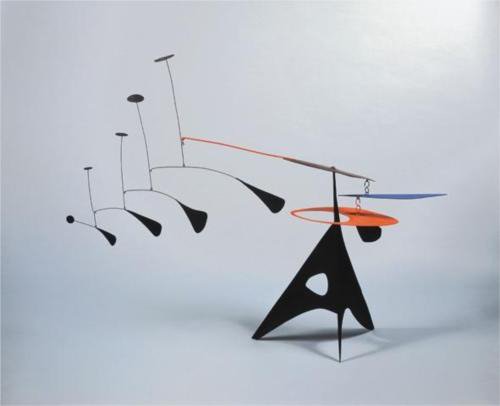Alexander Calder
dal 18/4/2013 al 6/6/2013
Segnalato da
18/4/2013
Alexander Calder
Pace London - Burlington Gardens, London
Calder After the War. The comprehensive exhibition of nearly fifty works of art from the years of 1945 to 1949 features more than twenty-five mobiles, stabiles, and standing mobiles installed on the gallery's ground floor with over twenty of Calder's rarely-seen paintings and gouaches from that same period at the gallery's newly renovated first floor.

Pace is honoured to present Calder After the War, a comprehensive exhibition of nearly fifty works of art from the years of 1945 to 1949, widely considered to be the most important period in the artist’s career. The exhibition will be on view at Pace London, 6 Burlington Gardens from 19 April to 7 June 2013.
Calder After the War will feature more than twenty-five mobiles, stabiles, and standing mobiles installed on the gallery’s ground floor. The exhibition will extend to the gallery’s newly renovated first floor, where over twenty of Calder’s rarely-seen paintings and gouaches from that same period will be on view.
Masterpieces such as Baby Flat Top (1946), Little Parasite (1947), and Blue Feather (c. 1948) will be included in the exhibition, as well as distinctive works like Scarlet Digitals (1945), Red, White and Blue on Black (1948), and Louisa’s 43rd Birthday Present (1948), a collection of five miniature standing mobiles and the felt-lined cigar box that Calder created to store them.
Calder’s 1930 visit to Piet Mondrian’s studio set in motion his pursuit of wholly abstract compositions in two and three dimensions. With his 1931 invention of a groundbreaking form of artwork termed the “mobile” by Marcel Duchamp, Calder successfully synthesised European Abstraction, Surrealism and Dada with an American passion for invention, discovery and forces of nature. Calder’s creative genius resulted in the redefinition of art beyond composition and material, as well as the liberation of the artwork from a static base and the true participation in the three-dimensional universe.
Calder’s radical new sculpture evolved over the decade until 1941, when the U.S. entered World War II, yielding an unexpected and important moment of reflection that interrupted the development of his sheet metal and wire work. Partly due to the shortage of sheet aluminium, but mostly to his own desire to reconsider his process during wartime, Calder experimented with the carved wood constructions known as Constellations, as well as the bronzes that he had first considered in the mid-1930s.
It was in 1945, when supplies of sheet aluminum returned to their previous abundance and, more importantly, the allies claimed victory, that Calder returned to his central focus: mobiles, stabiles, and standing mobiles. James Johnson Sweeney, chief curator of the Museum of Modern Art, who had organised Calder’s retrospective in that institution in 1943, later noted:“1945 saw him once more working sheet metal, wire and wood as he had for so many previous years, but now with a new grace and a fresh treatment of pierced planes made to swim lazily horizontal. At the same time, Calder’s stabiles took on a greater complexity of interpenetrating geometrical forms. Now the pierced elements helped to a new lyrical effect.”
Calder After the War demonstrates the artist’s visionary engagement with form, colour, gesture, and complexity in the four years that followed. The works of this period are distinguished not only by the grace and balance of their systems, but by the intricacy, unpredictability, and interacting forces that brought the work to a radical new level, as Calder merged stabile and mobile constructions and introduced sophisticated weights and cantilevers.
Eager to exhibit in Europe and abroad following the war, Calder presented some of the seminal exhibitions of his career during this period: Galerie Louis Carré, Paris, in 1946, for which Jean-Paul Sartre wrote an essay; Buchholz Gallery/Curt Valentin, New York, in 1947; the San Francisco Museum of Art in 1947; and his sojourn to Brazil in 1948. Many of the most important works from these exhibitions are represented in Calder After the War.
A major catalogue, Calder After the War, with an introduction by Sir Norman Foster and an important new essay by American art historian Barbara Rose, will accompany the exhibition. The volume will include illustrations of the works in the exhibition as well as a chronology of the period, which will include dozens of never-before-published photographs documenting the artist, his studio, and his practice. Photographs of the important exhibitions that marked the period, as well as related documentation, will also be reproduced in the chronology.
Calder After the War is the second in a series of historical exhibitions focusing on seminal moments in Calder’s career, following the acclaimed Calder 1941, presented in New York in 2011. The exhibition continues Pace’s four-decade relationship with the Calder Estate, during which the gallery has presented a dozen exhibitions of the artist’s work.
Image: Alexander Calder, Blue Feather, 1948
For press inquiries, please contact:
London: Nicolas Smirnoff, nicolas@pacegallery.com / +44 203 206 7613
New York: Sarah Goulet, sgoulet@pacegallery.com / +1 212 421 8987
Pace London
6 Burlington Gardens - London, W1S 3ET, UK
Mon - Sat 10 to 6



